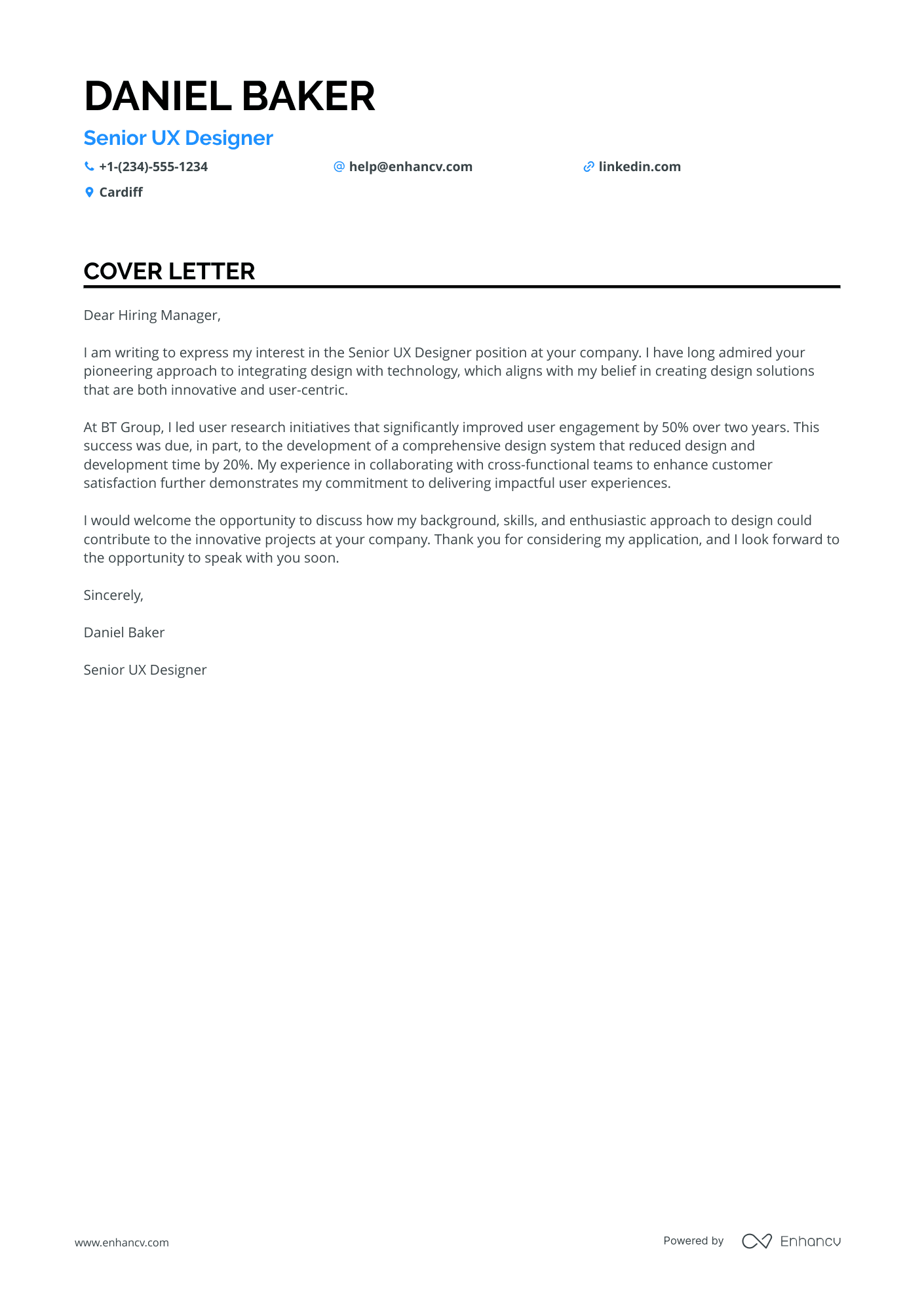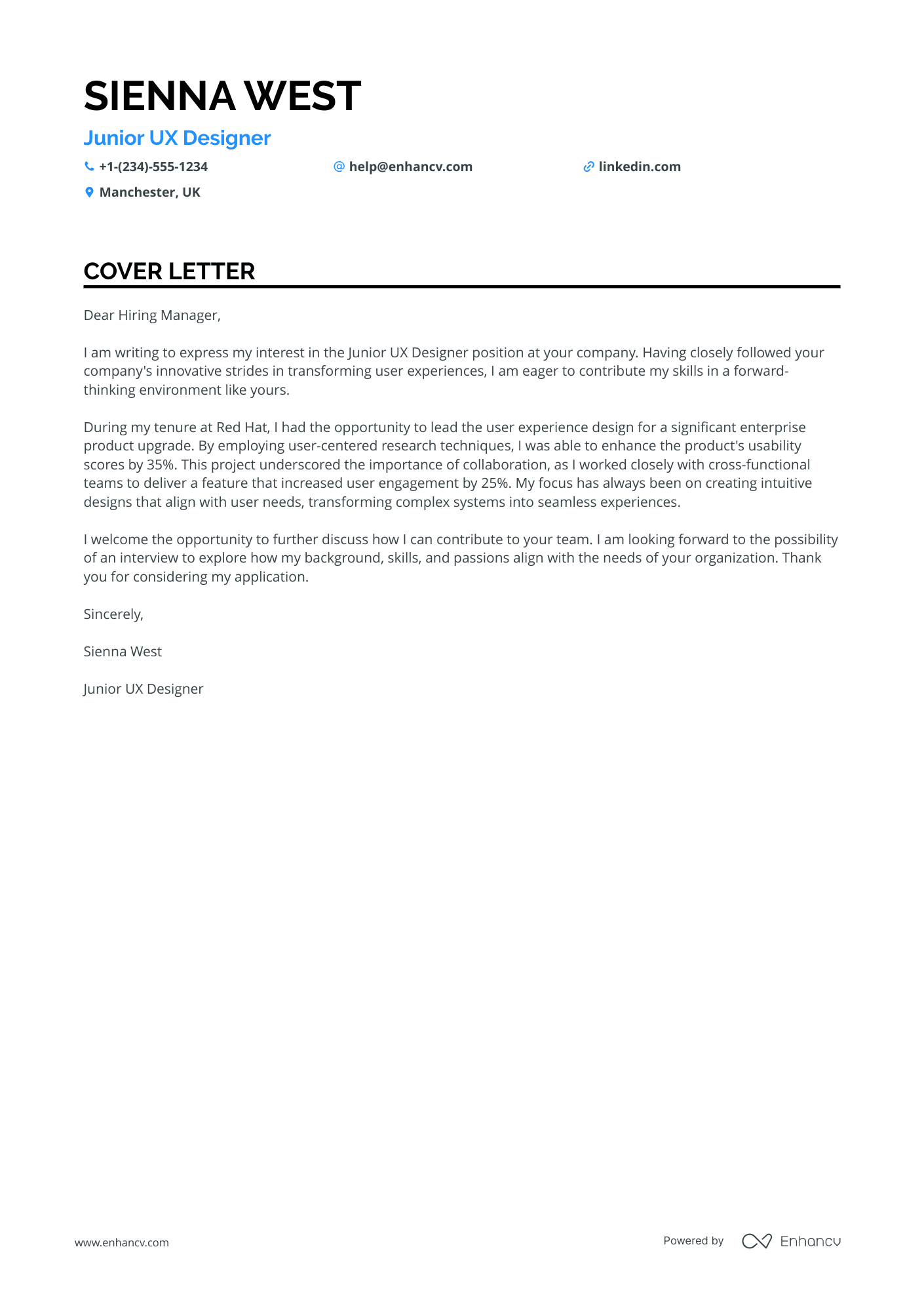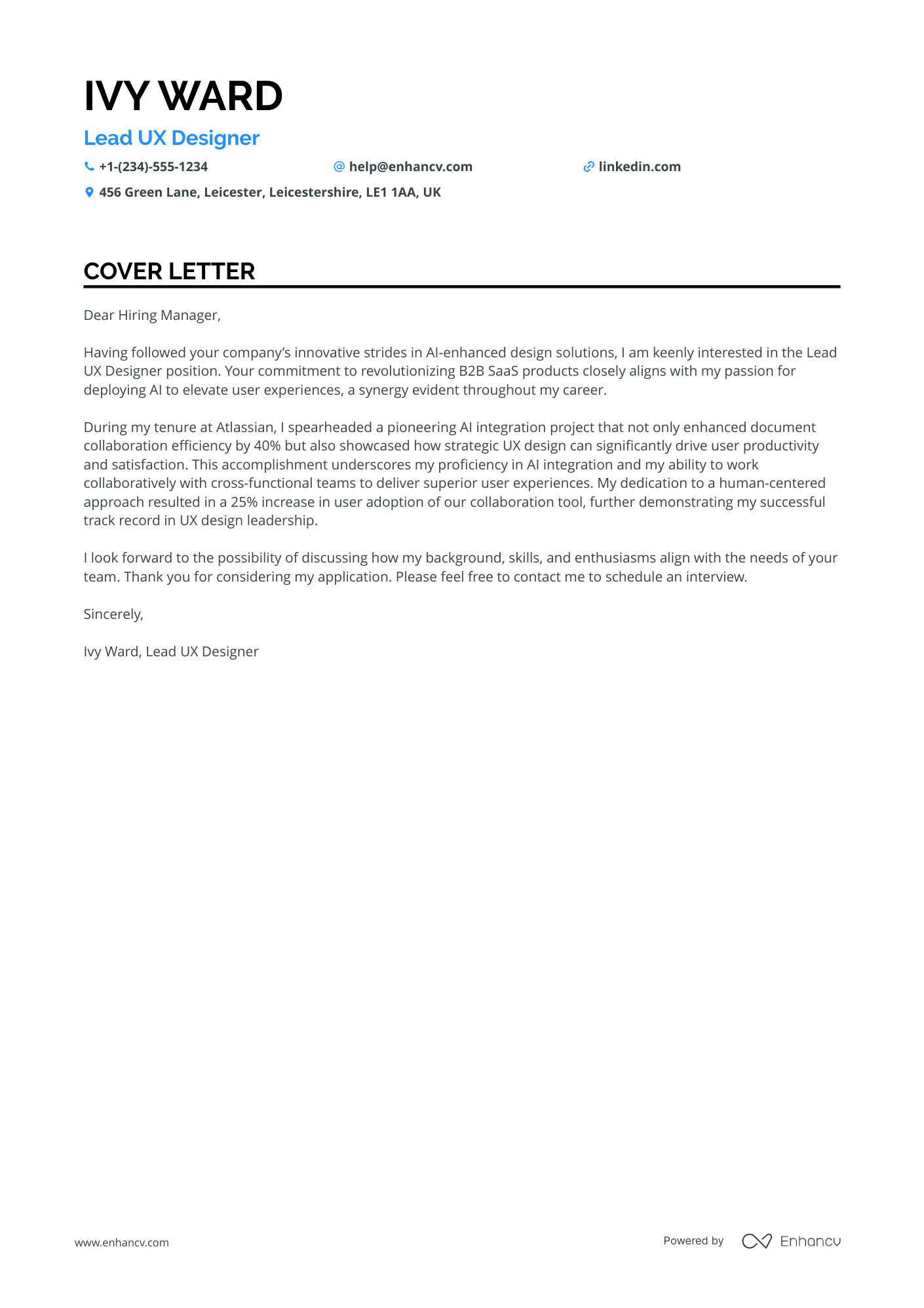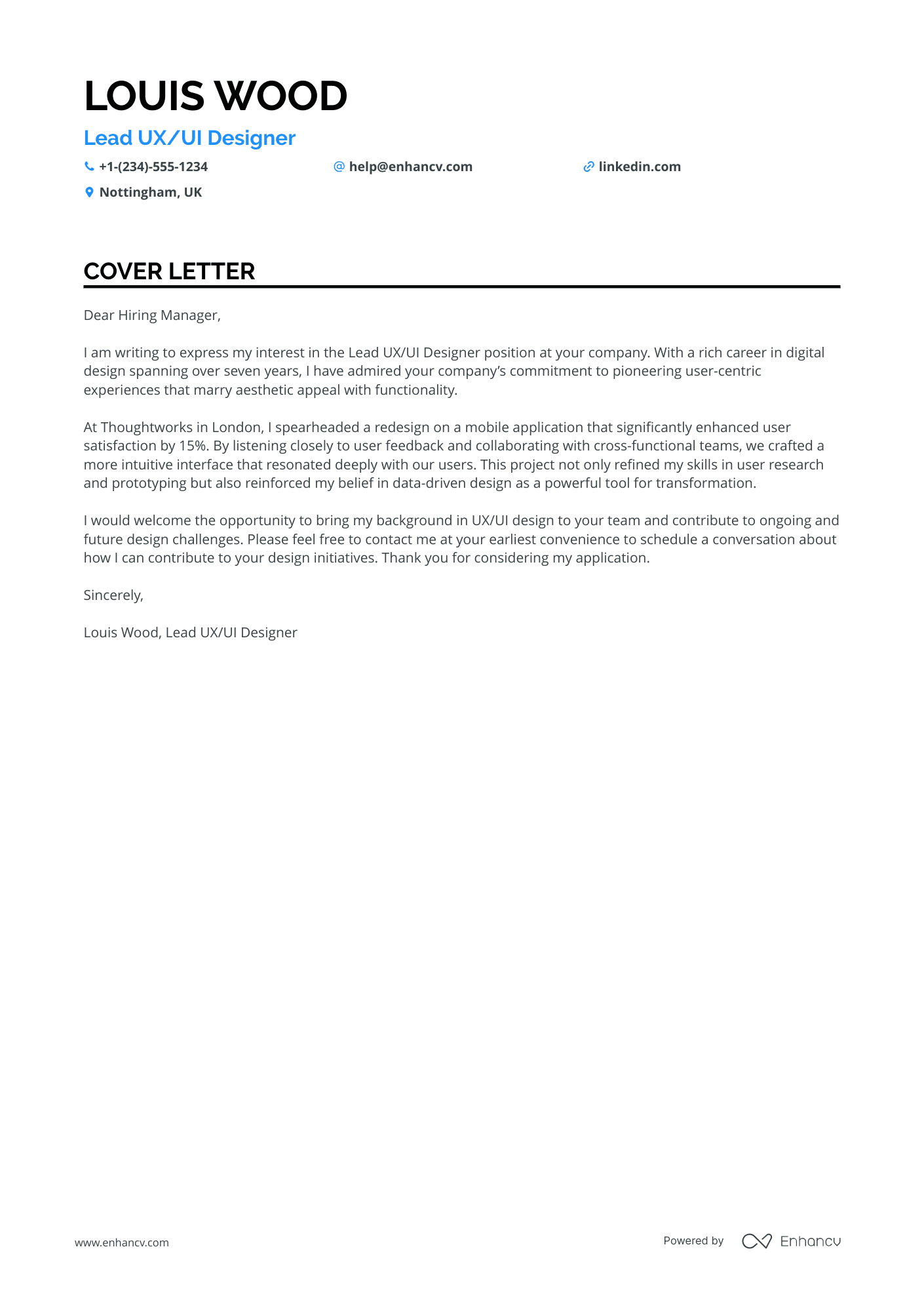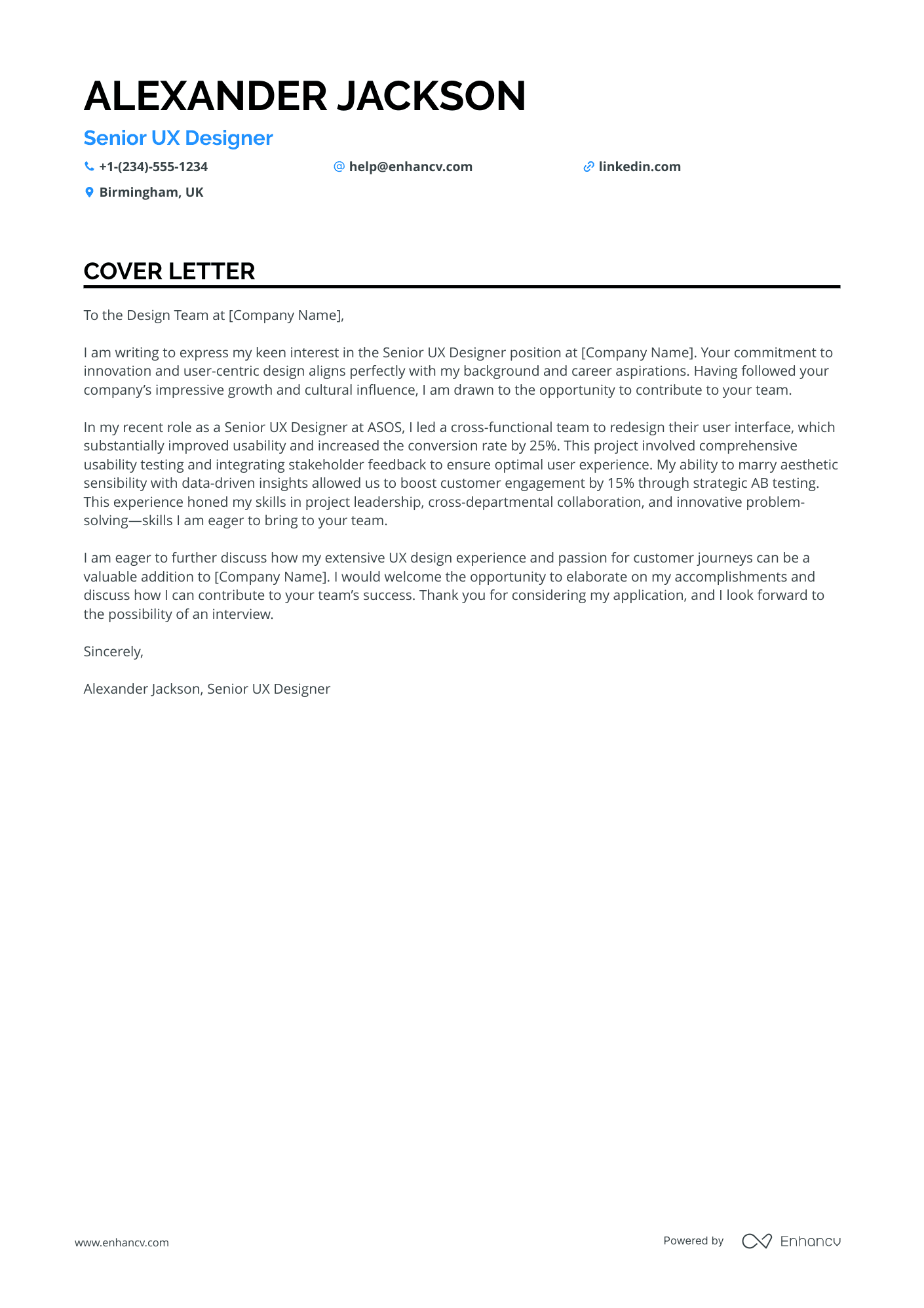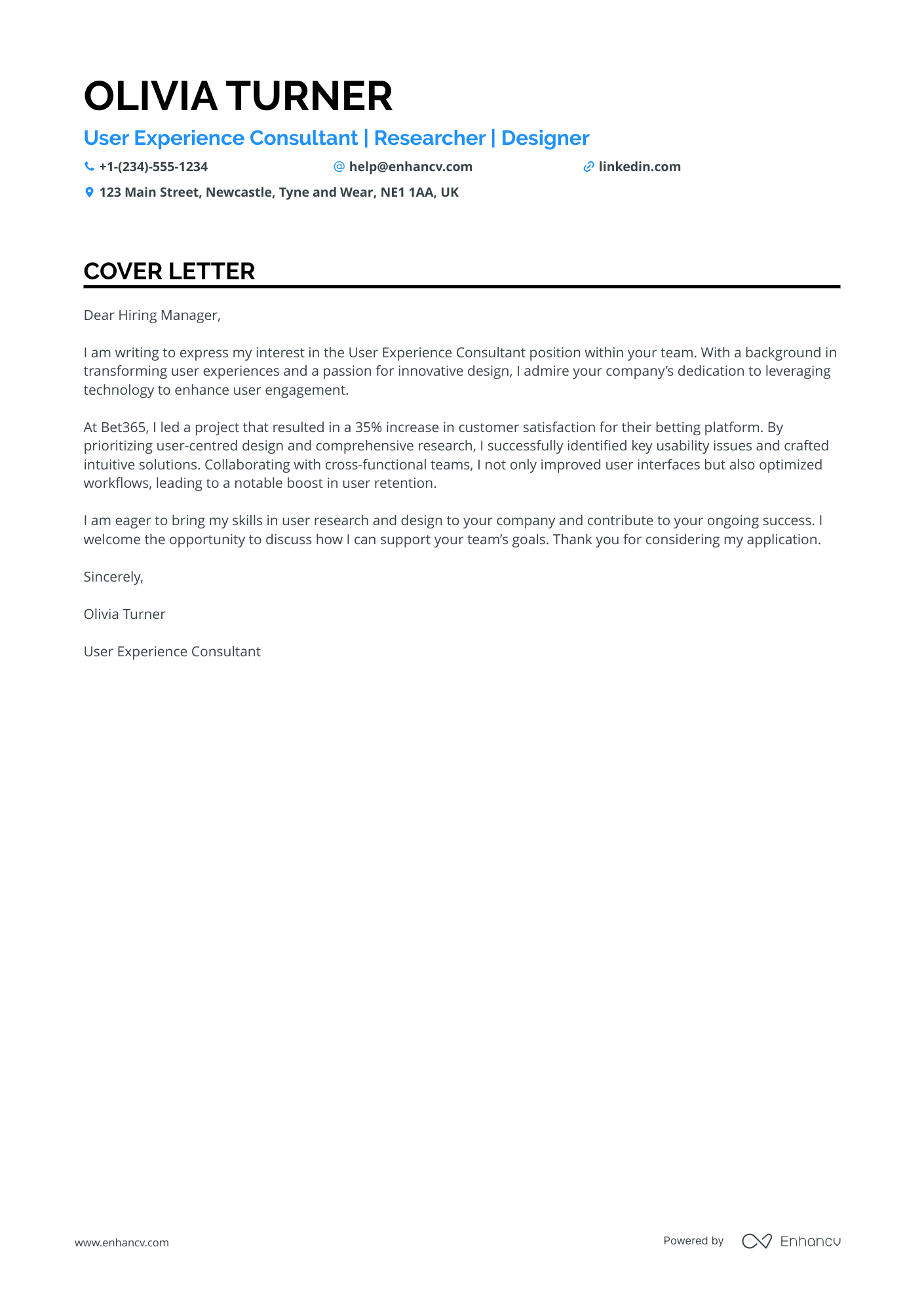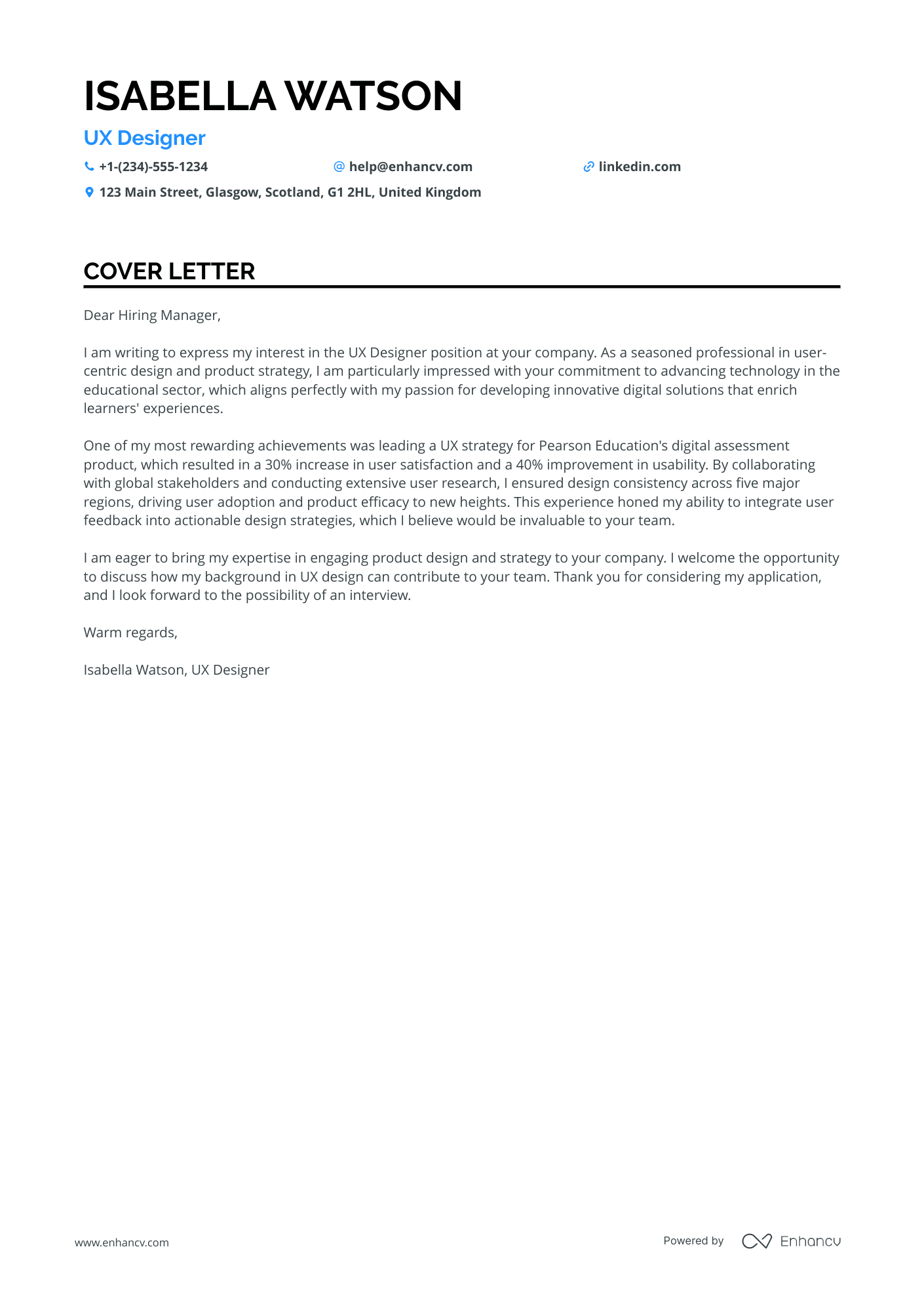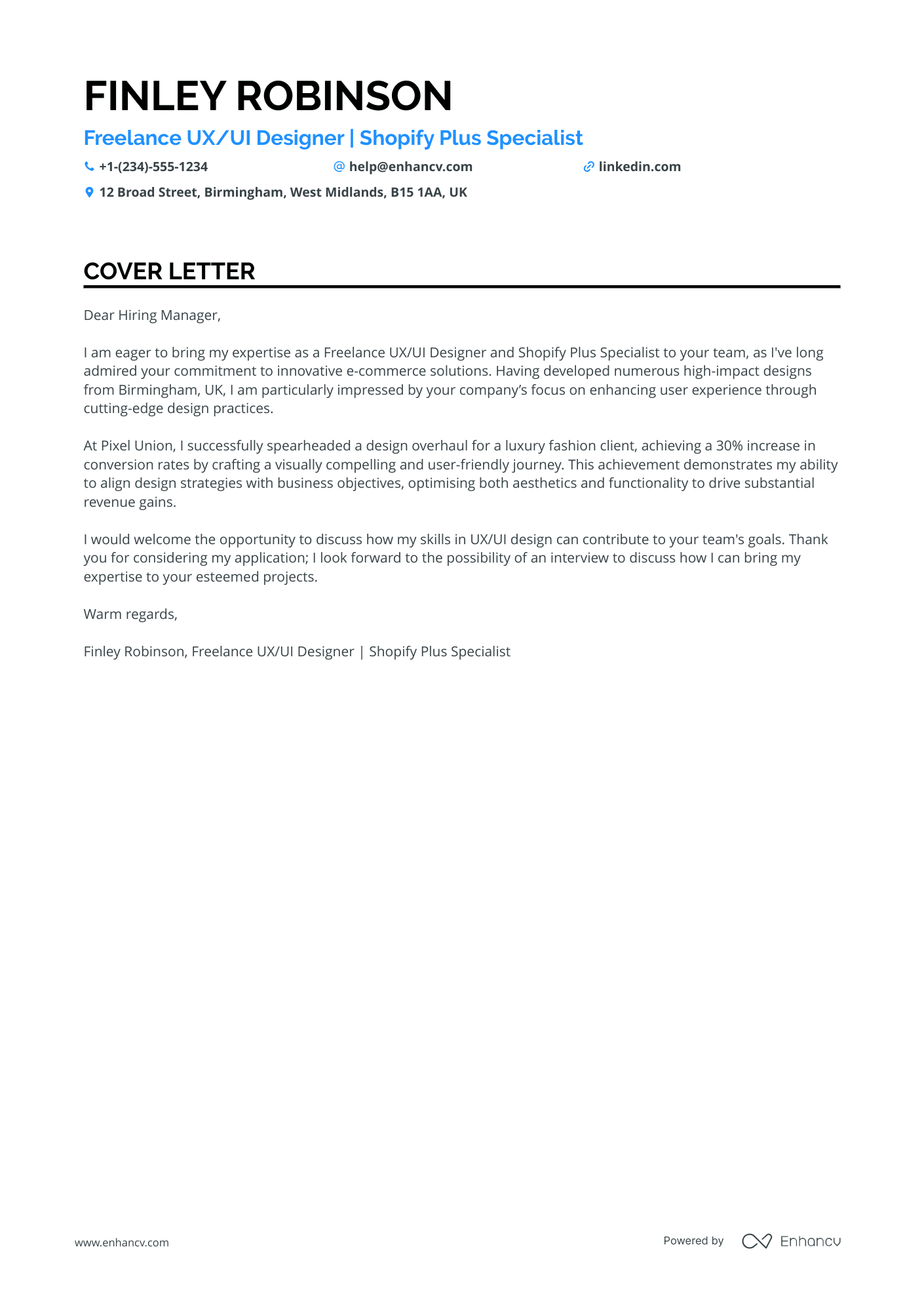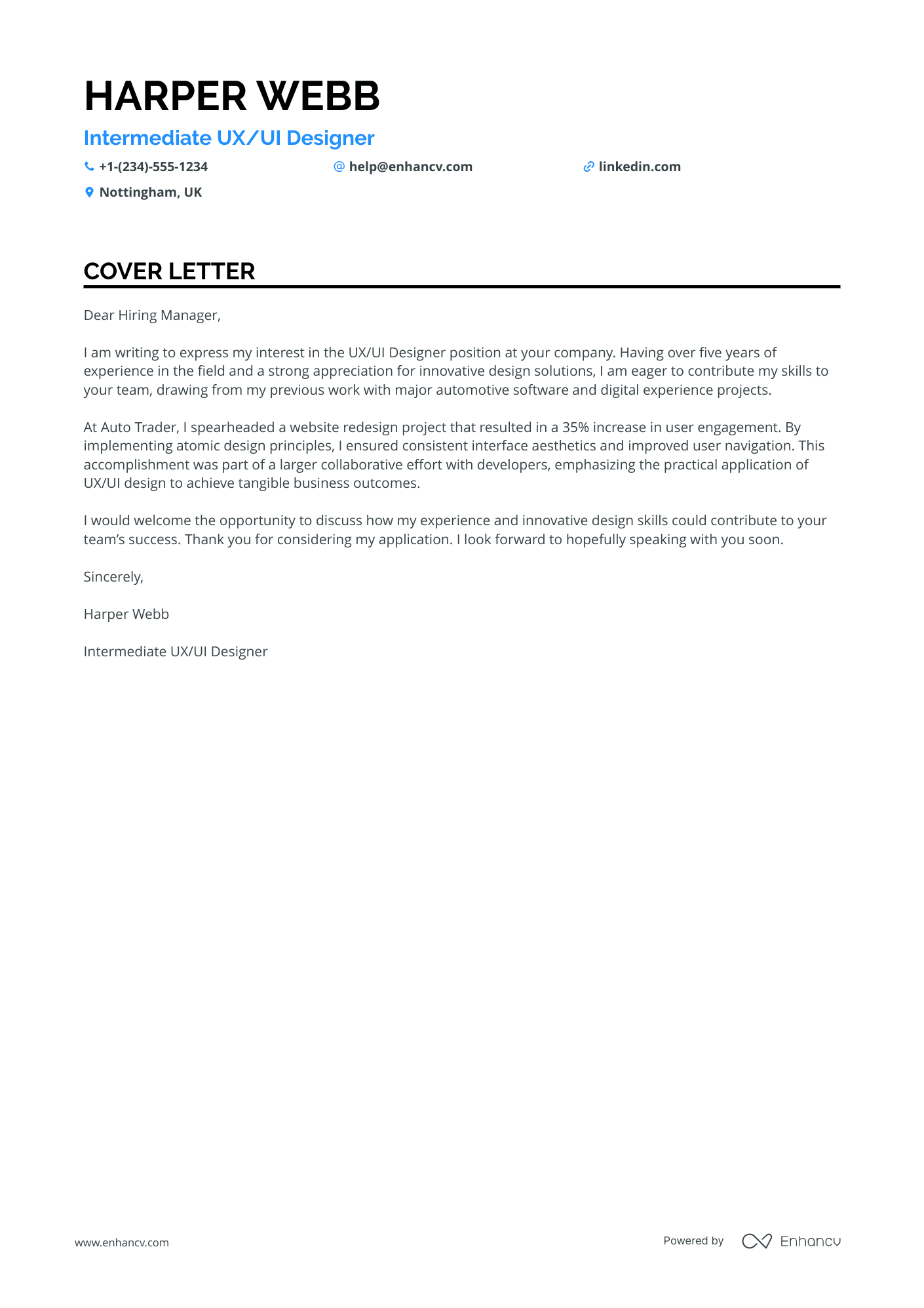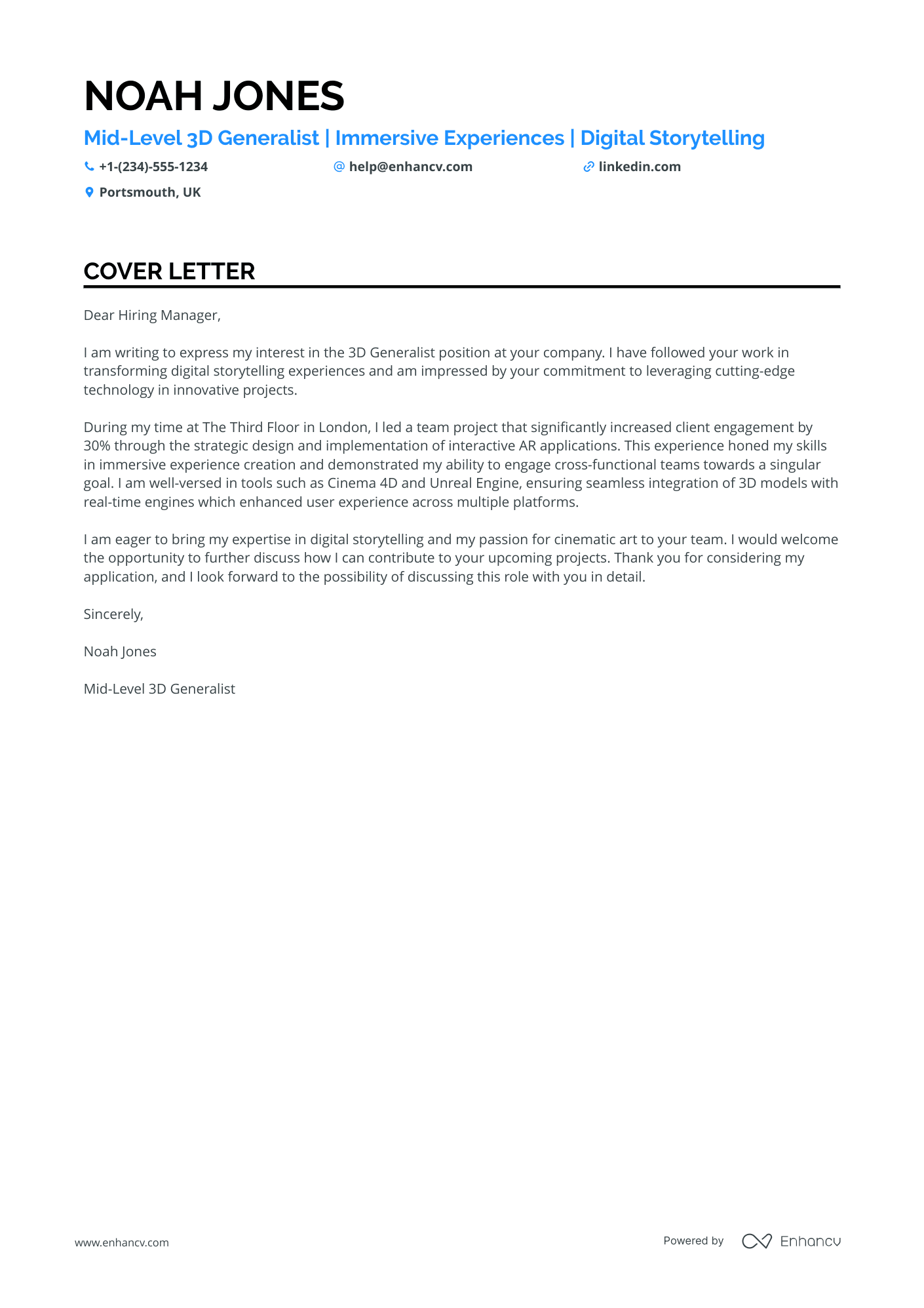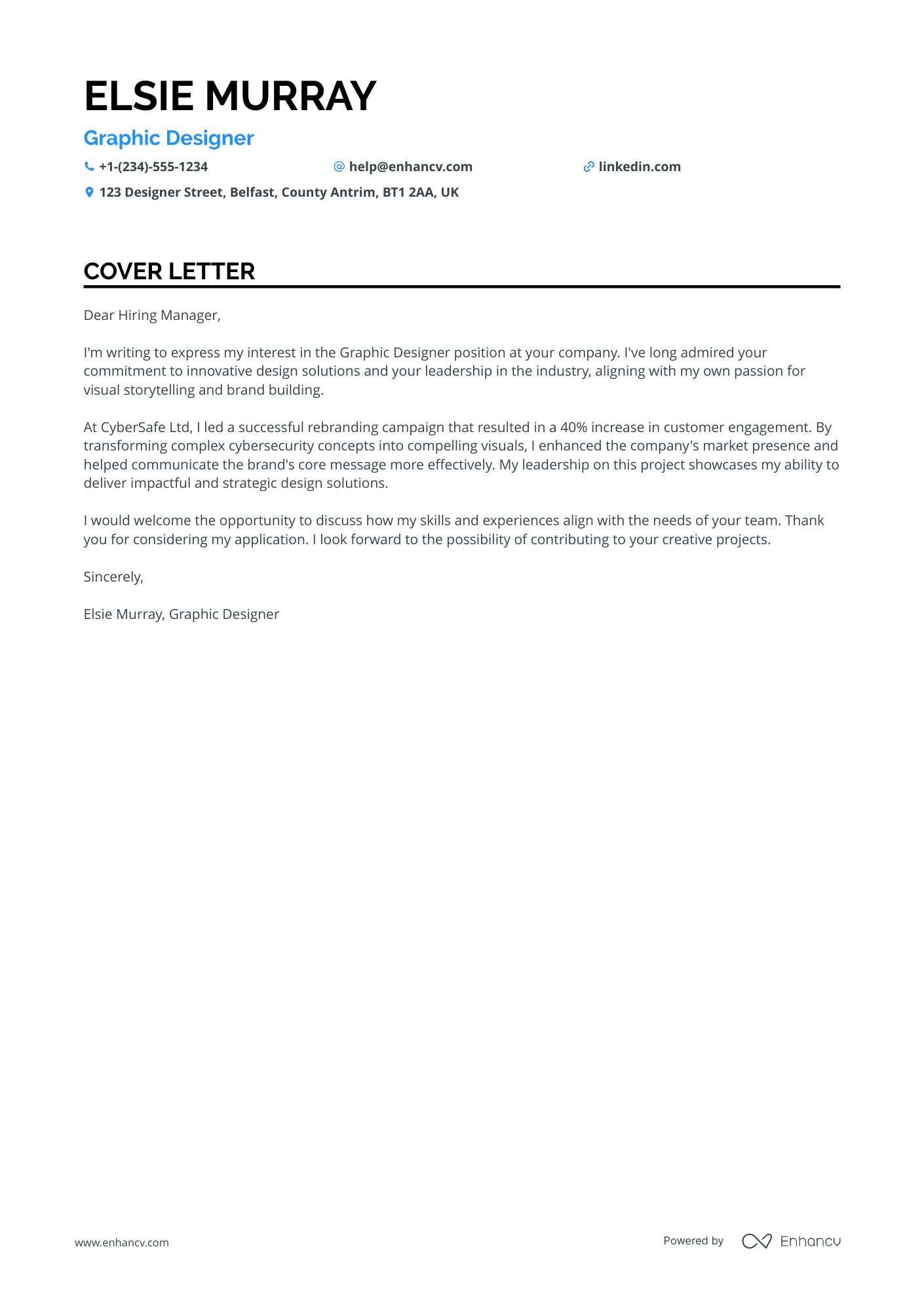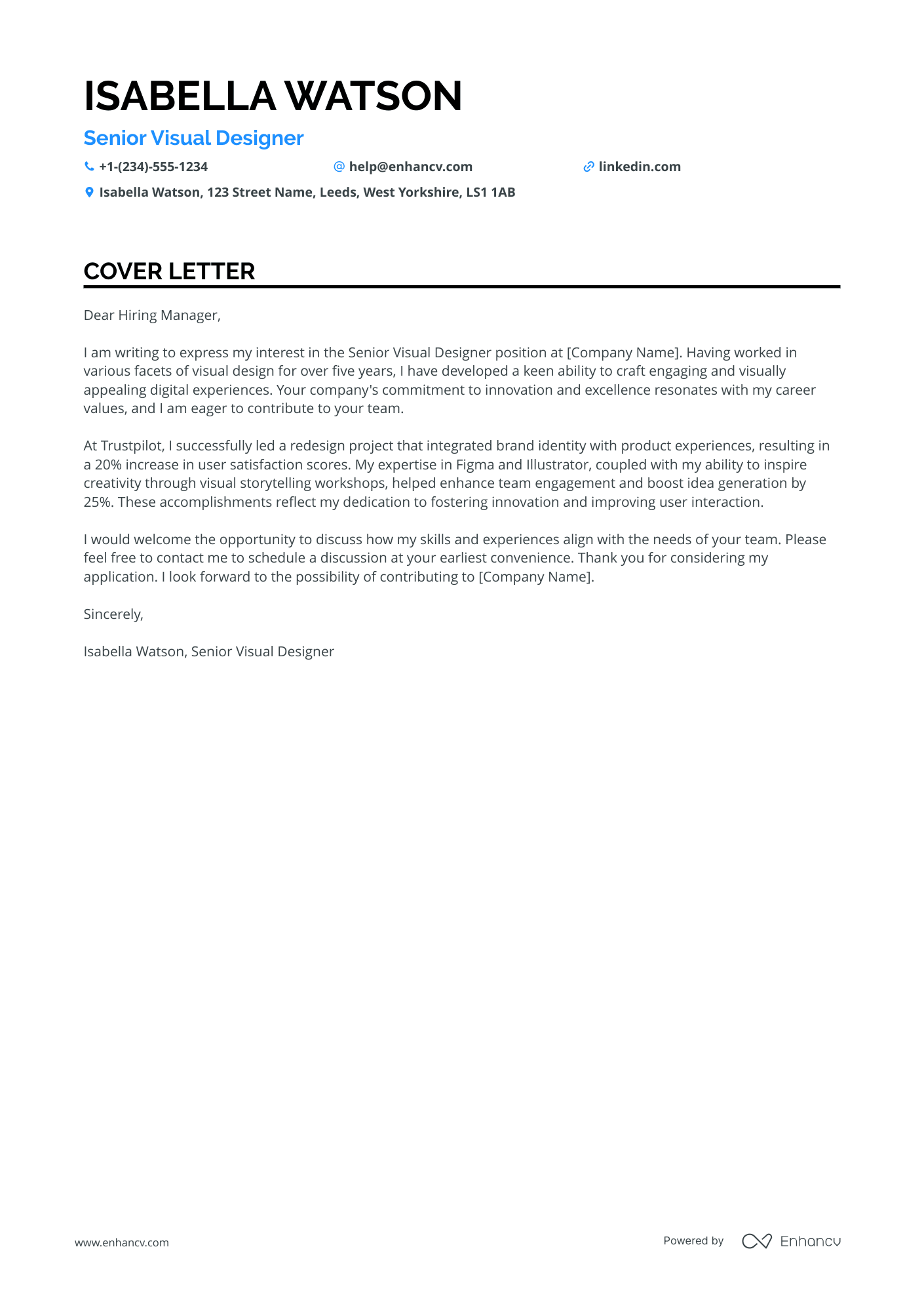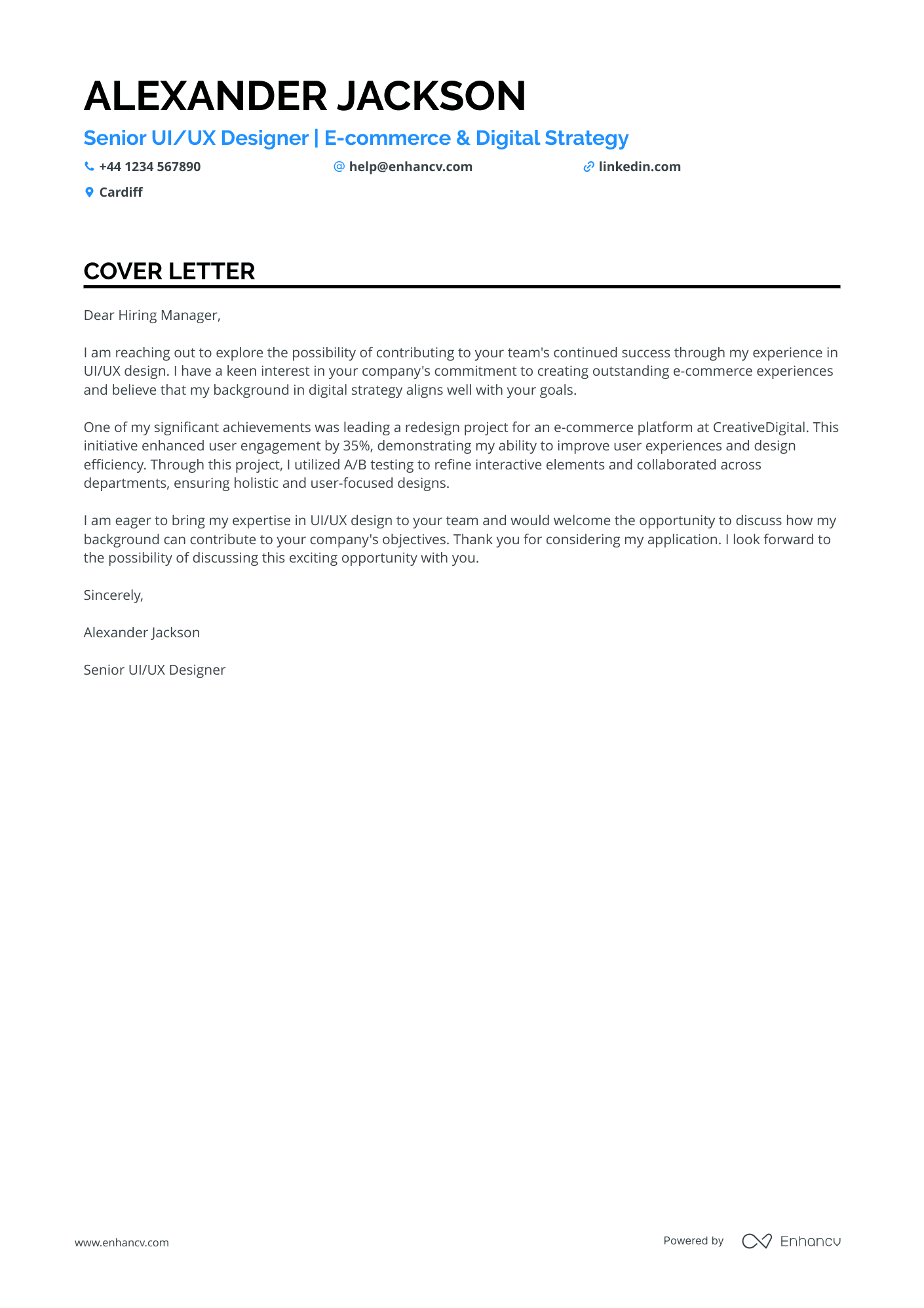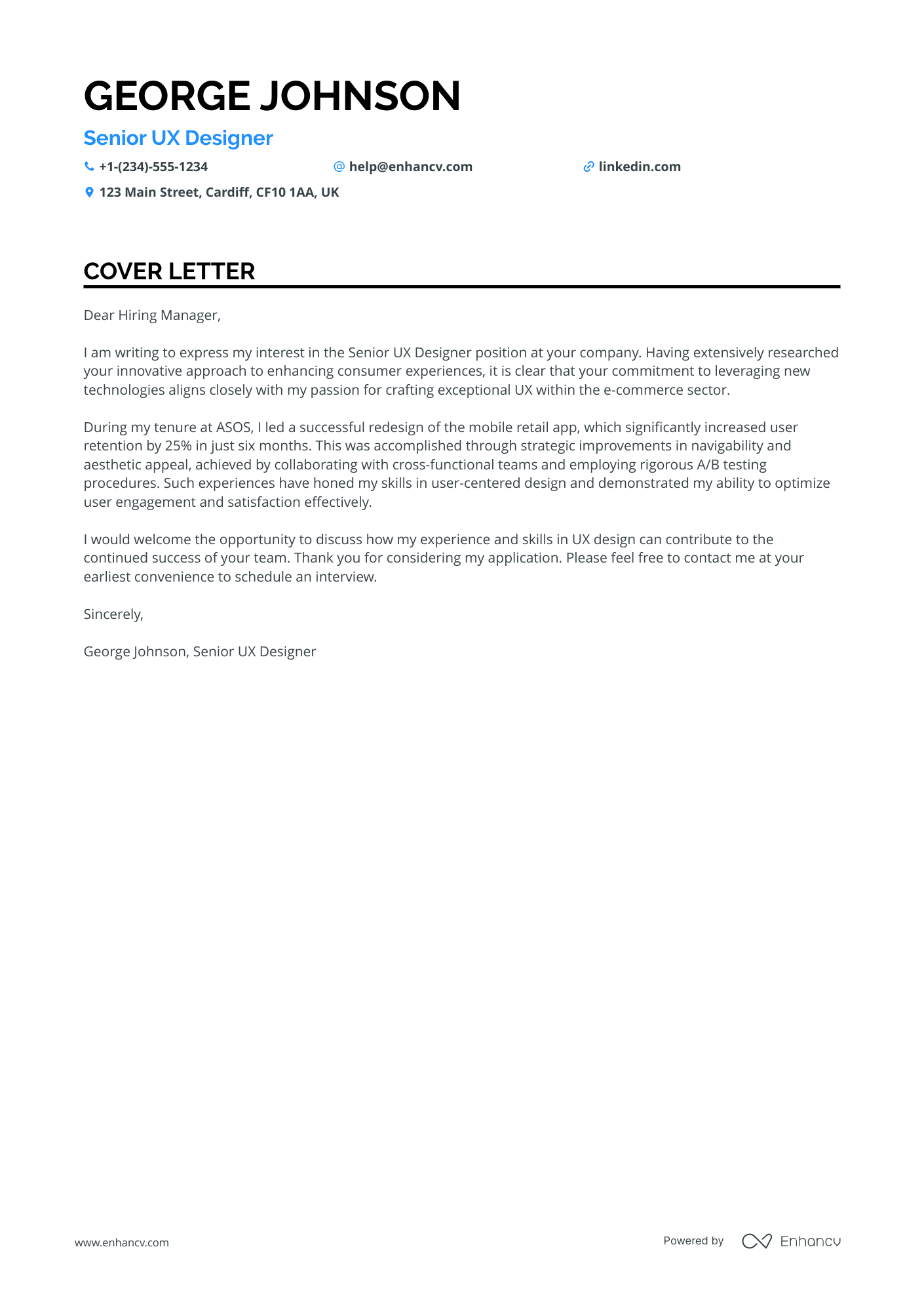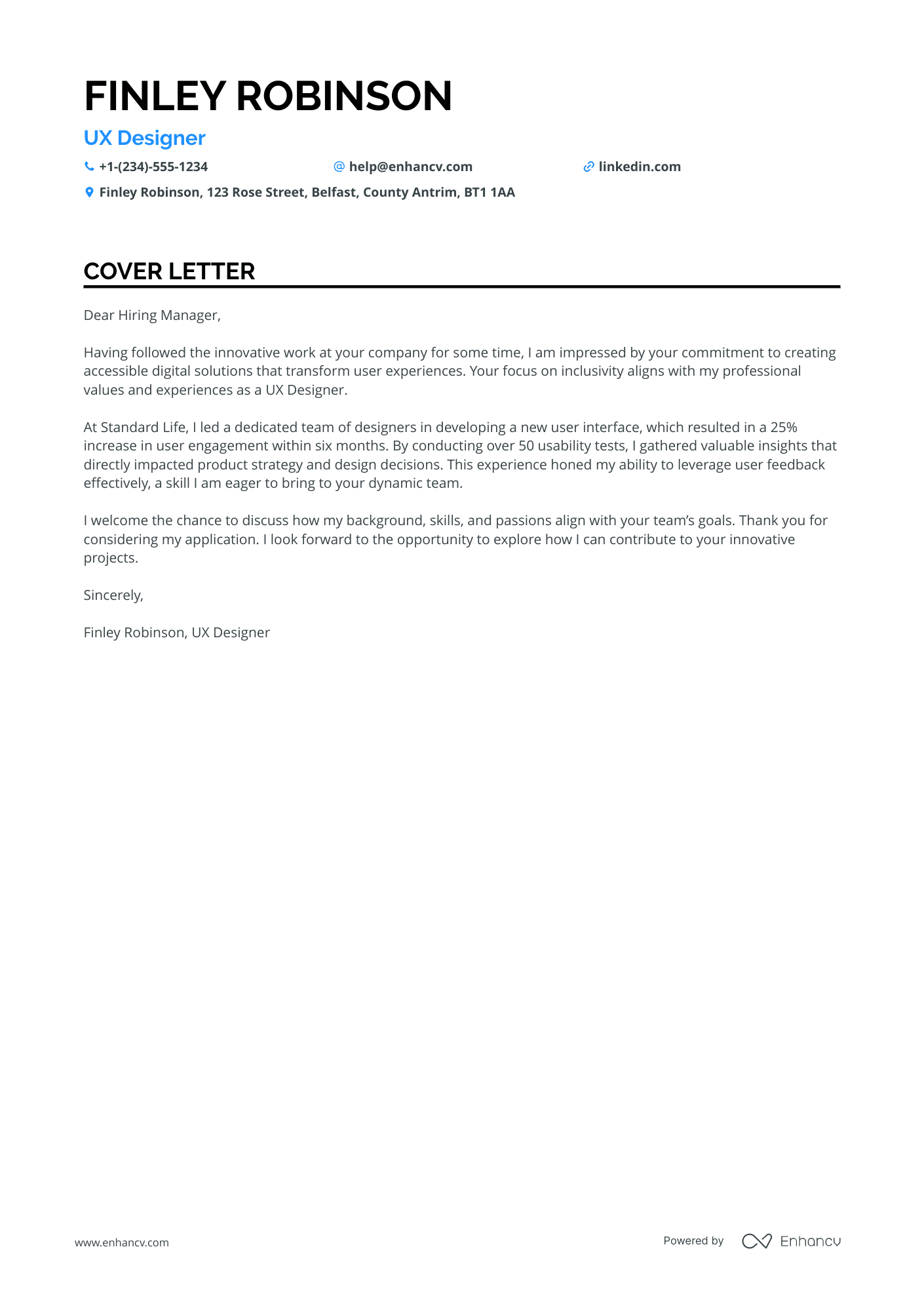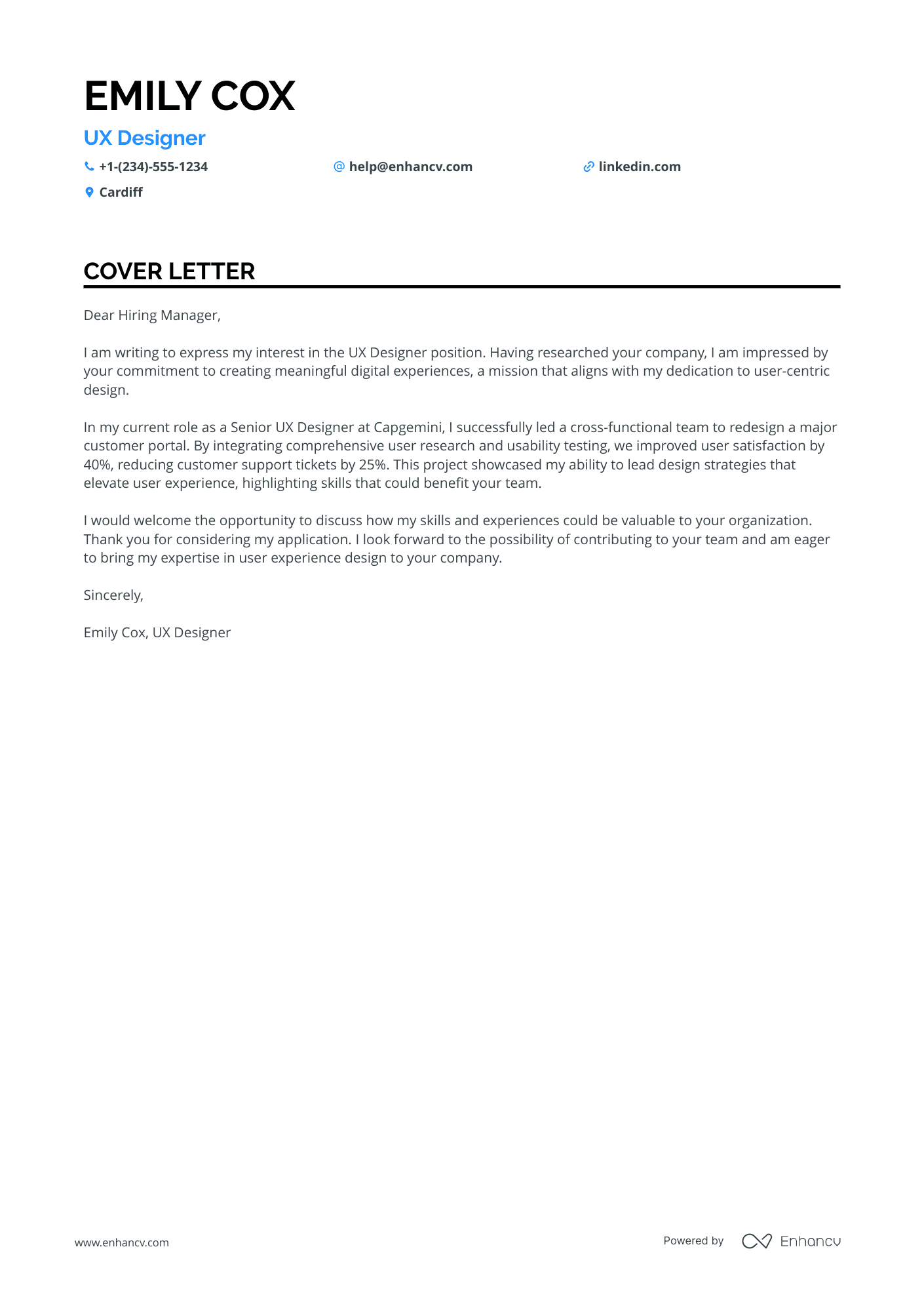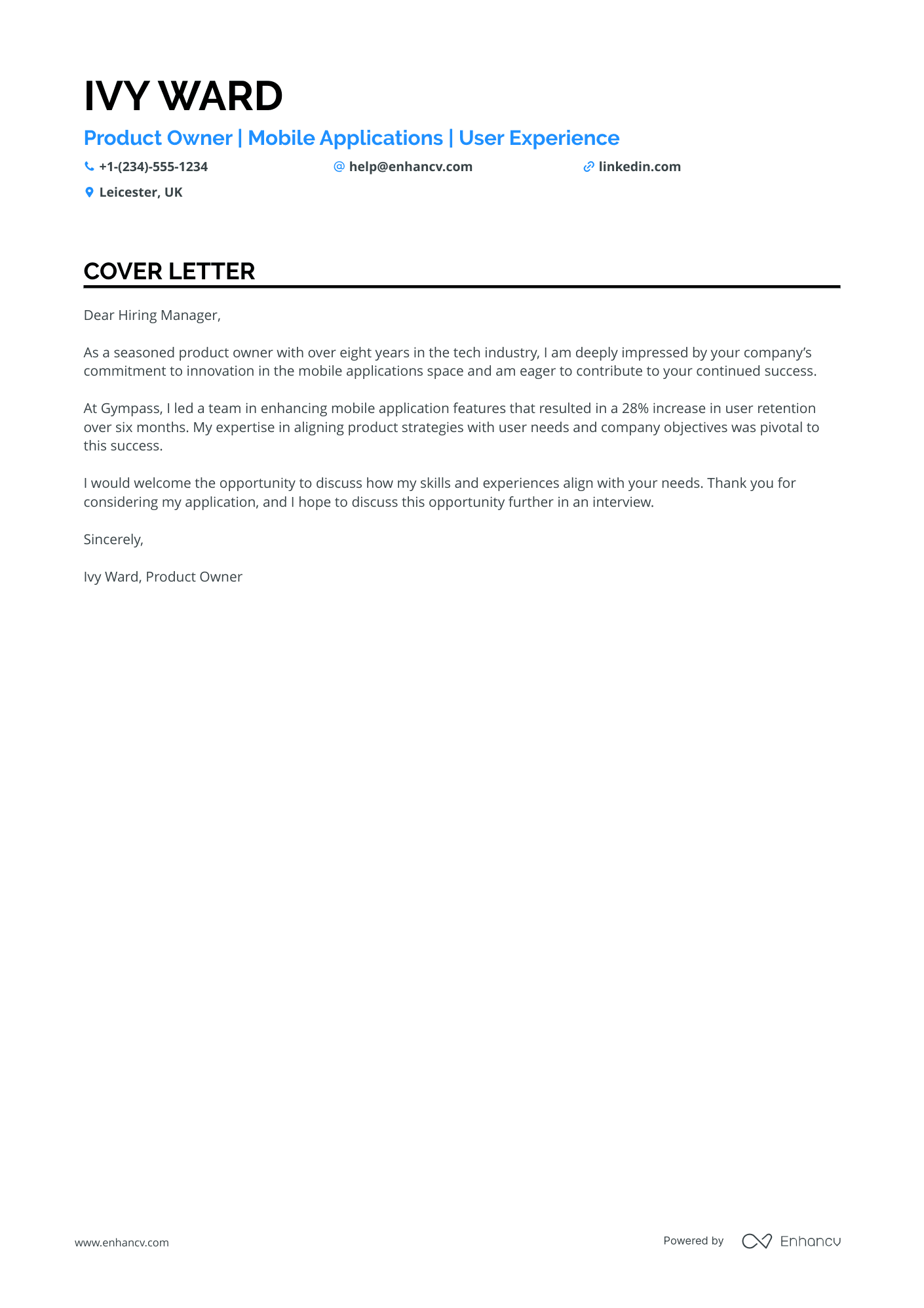You’ve just sent the same cover letter to 60 different job roles, all beginning with “Dear Sir or Madam” and ending with 'Yours sincerely.'
Bad news: you may have just missed your chance to stand out, as generic cover letters are a very common pitfall in job applications.
Did you know recruiters typically shortlist candidates based on how well they meet the job criteria? Failing to address the key requirements can cost you the role.
In this guide, we’ll show you how to tailor your cover letter to align with the job advert or company, ensuring you showcase your value as a candidate.
Cover letter examples for ux designer
By Experience
Senior UX Designer
- Highlight Relevant Experience: The cover letter effectively outlines Daniel's extensive experience in UX design by showcasing leadership roles at well-known companies, such as BT Group and Sky, solidifying his expertise in the field.
- Emphasise Measurable Achievements: By quantifying achievements, like increasing user engagement by 30% and improving task completion rates by 40%, the letter demonstrates Daniel's ability to deliver tangible results, which is crucial for a Senior UX Designer role.
- Mention Specific Skills: The letter details specific skills, such as proficiency in Figma and Zeroheight, which are essential tools for modern UX design, making Daniel a strong candidate for the position.
- Include Relevant Education: Daniel's educational background in Human-Computer Interaction and Graphic Design is highlighted, showcasing a solid foundation in both theoretical and practical aspects of UX design.
Junior UX Designer
- Experience with Tech Giants: Highlighting experience with prominent companies like Red Hat and Atlassian showcases credibility and familiarity with high-stakes design environments, essential for a UX Designer role.
- Proven Impact through Metrics: Using quantifiable achievements (e.g., improvements in usability scores, reductions in design debt) demonstrates the tangible impact of design contributions, making your case stronger.
- Emphasis on Cross-Functional Collaboration: Mentioning successful collaborations with product managers and engineers emphasises a crucial skill for UX roles, as they often require teamwork across different departments.
- Commitment to Continuous Learning: Listing courses and continuing education, such as 'Human-Computer Interaction', signals a commitment to keeping skills up to date and a proactive approach to professional development.
Lead UX Designer
- Highlighting Experience in B2B SaaS: The cover letter effectively showcases a rich background in UX design for B2B SaaS products, crucial for positions involving software as a service innovation.
- Emphasis on AI Integration: Mentioning AI integration projects underscores familiarity with modern tech trends and positions the candidate as forward-thinking, which is particularly valuable in the tech industry.
- Proven Results in User Satisfaction: Quantifying improvements in user satisfaction, such as a 30% increase, effectively demonstrates the candidate's positive impact on previous projects.
- Stakeholder Management Skills: Highlighting stakeholder workshops and strategic project approvals illustrates the candidate's capability to engage and influence decision-makers successfully.
Entry-Level UX Designer
- Highlight Relevant Experience: Emphasise substantial experience in UI/UX design by describing previous roles and their impact, such as increased user satisfaction and engagement.
- Showcase Certifications and Education: Mention relevant courses and degrees, such as a Master of Arts in User Experience Design and certifications like "Certified Usability Analyst," to demonstrate specialised knowledge.
- Use Quantifiable Achievements: Use statistics to underline accomplishments, such as "a 40% increase in mobile user retention" and "reducing project delivery times by 20%," to show results-oriented success.
- Emphasise Key Skills: Highlight essential skills like "Adobe XD," "Figma," and "User-Centered Design" to align with job requirements and industry standards.
Principal UX Designer
- Expertise Demonstration: The cover letter showcases over 12 years of hands-on experience in UX Design, providing credibility and expertise in the field, especially for a Principal role.
- Relevant Accomplishments: Specific project outcomes, such as increasing user engagement by 30% and enhancing team proficiency by 40%, directly align with the metrics-driven approach common in senior UX roles.
- Specialisation Highlight: The emphasis on developing living room experiences and pioneering customer-centric solutions signals a specialised focus, crucial for roles in entertainment and media companies.
- Leadership and Influence: Proven leadership as evidenced by running global design initiatives and spearheading training programmes, demonstrating the ability to lead teams and influence organisational strategies.
Mid-Level UX Designer
- Highlighting a strong track record of measurable achievements, such as increasing user satisfaction by 25%, effectively conveys impact and success in roles, aligning with business objectives.
- Providing details on leadership experience and mentoring junior designers emphasises management skills, which are crucial for a Lead UX/UI Designer role.
- Emphasising proficiency in relevant technical tools and design methodologies showcases technical competence, essential for creating and improving user experience designs.
- Including specific language proficiency and cultural interests, like travelling, implies an ability to work in diverse and global environments, which is beneficial in design roles focussed on user-centricity.
By Role
UX Designer in Healthcare
- Alexander Jackson's cover letter effectively highlights his extensive 10-year experience in UX design, emphasising his proficiency with tools like Figma and Google Analytics, which are crucial for a Senior UX Designer role.
- The cover letter showcases significant achievements such as leading a global project that increased user satisfaction by 30%, conveying a strong track record of impactful leadership in UX design.
- The candidate's education, including a Master of Science in Human-Computer Interaction, underlines a specialised knowledge base, reinforcing credibility and relevance to the UX design field.
- Alexander effectively notes his leadership and project management skills, essential qualities for senior roles, through his experience in reducing project delivery times and managing cross-functional teams.
UX Designer for Mobile Applications
- Emphasises strong collaboration skills by detailing multidisciplinary teamwork and mentoring experience, crucial for a Senior UI/UX Designer role.
- Highlights achievements with quantifiable metrics, such as increasing user engagement and reducing project timelines, showcasing impact and effectiveness.
- Showcases relevant technological proficiency in tools like Sketch and Figma, which are essential in mobile UI/UX design and game development.
- Mentions prestigious awards and recognitions, like the Game UI Design Award, to underline credibility and excellence in the field.
UX Designer in E-commerce
- Emphasising the applicant's extensive experience as a UX Designer for over eight years, especially in leading innovative consumer product projects, which aligns perfectly with the role of a Senior UX Designer.
- Highlighting significant achievements such as enhancing user retention by 25% and increasing user engagement conversion by 15%, demonstrating the candidate’s capability to deliver impactful results in previous roles.
- Detailing collaborative efforts with cross-functional teams, showcasing essential skills such as collaboration and communication that are critical for the Senior UX Designer role.
- Mentioning certifications and courses in areas such as Human-Centred Design and Interaction Design Specialisation indicates the applicant's continuous learning and expertise in relevant, specialised areas.
UX Designer for Gaming Industry
- Highlighting specific achievements and improvements, such as leading the redesign of a major betting platform and increasing user satisfaction scores by 35% and raising retention rates by 25% with a new app launch, strengthens the candidate's expertise in impact-driven design.
- The mention of concrete skills such as HTML, CSS, and proficiency with Figma alongside key UX practices like wireframing and prototyping gives a comprehensive overview of the candidate's technical capabilities relevant to the role.
- Emphasising advanced education in User Experience Design and additional certifications in advanced user research and design thinking can offer reassurance to potential employers of the candidate's formal preparation and commitment to further development in the field.
UX Designer for Financial Services
- Emphasising specialisation in UX design tools such as Figma and Sketch showcases the candidate’s technical skills essential for creating effective user-centred designs.
- Highlighting specific achievements, like the 30% increase in user engagement through UI updates, provides tangible evidence of the candidate’s ability to impact product success.
- Demonstrating cross-functional collaboration with Engineers and Product Managers shows the candidate’s ability to integrate design strategies with broader business goals, a crucial aspect for UX roles.
- Mentioning certifications, such as the 'Certified Professional in Accessibility Core Competencies', underlines the candidate’s commitment to accessibility, which is increasingly vital in UX design.
UX Designer in Education Technology
- Relevant Experience Highlight: The cover letter effectively showcases Isabella's extensive experience in UX design, specifically within educational technology, with a focus on user-centric design and product strategy. This is crucial for demonstrating her expertise and fit for future roles.
- Quantifiable Achievements: It includes specific metrics that illustrate the impact of her work, such as increasing user satisfaction by 30% and enhancing market share by 20%, making her achievements tangible and compelling for potential employers.
- Focus on Accessibility and Inclusivity: Advocacy for accessibility in design, achieving WCAG compliance and fostering inclusivity, is highlighted, demonstrating commitment to creating universally accessible experiences, a critical aspect in modern UX roles.
- Educational Background and Continuous Learning: A strong academic background with a Master's in Human-Computer Interaction is mentioned, alongside a passion for continuous learning, positioning her as a candidate continually seeking growth and new insights in UX design.
Freelance UX Designer
- Highlight industry-specific skills: Emphasise key skills such as e-commerce design, responsive design, and Figma proficiency, which are crucial for a UX/UI Designer specialising in Shopify Plus.
- Showcase impactful achievements: Mention quantifiable achievements, such as increasing conversion rates by 30% and boosting mobile traffic engagement by 40%, to demonstrate the tangible impact of your work.
- Include relevant education and certifications: Reference relevant qualifications, such as a Master of Science in Digital Media Design and the "Responsive Web Design Specialist" certification, to reinforce your expertise and continuous learning.
- Illustrate collaboration and leadership skills: Emphasise experience in leading teams, managing end-to-end project delivery, and implementing collaborative tools, to highlight your ability to work effectively with others and lead successful projects.
UX Designer for Automotive Industry
- Highlight Relevant Experience: Emphasise specific UX/UI projects that resulted in significant improvements, such as a 35% increase in user engagement or a 40% boost in customer satisfaction, to showcase the impact of your design capabilities.
- Certifications and Continuous Learning: Mention completed courses like "Advanced UX Design Strategies" from Nielsen Norman Group to demonstrate dedication to ongoing professional development and expertise in advanced design techniques.
- Data-Driven Approach: Illustrate your proficiency in using tools such as Hotjar and Google Analytics to drive design changes, emphasising the importance of data-driven decision-making in improving user experience and conversion rates.
- Cross-Functional Collaboration: Highlight your experience in working closely with developers and marketing teams to align design and business goals, as well as leading workshops to instill a user-centric approach within the organisation.
UX Designer in Virtual Reality
- Emphasising the combination of technical skills and experience in immersive digital storytelling enhances a candidate's fit for roles centred around innovative media production.
- Showcasing successful cross-functional projects and awards won underscores a candidate's ability to collaborate effectively and contribute to high-impact outcomes in creative environments.
- Highlighting specific technical proficiencies, like Cinema 4D and Unreal Engine, that are directly applicable to task requirements helps reassure potential employers of the candidate's capability and readiness.
- Referring to productivity improvements and process automation indicates a candidate's focus on efficiency and ability to drive operational enhancements within digital content creation roles.
UX Designer for Non-Profit Organisations
- Emphasising specific experience in user-centric design and using Figma highlights Emily's alignment with modern UX design practices, which is crucial for a UX Designer role.
- Mentioning achievements such as a 30% increase in user engagement and a reduction in support tickets demonstrates a proven track record of making meaningful impact, a valuable asset in UX roles.
- Citing the integration of WCAG accessibility standards shows a commitment to inclusivity in design, an increasingly important aspect in the UX field.
- Referencing a UX Design Certification from the Nielsen Norman Group underscores a strong foundation in UX principles, which could give an edge over other candidates.
UX Designer in Cybersecurity
- The cover letter effectively highlights Elsie's extensive experience in the industry, specifically her ability to transform complex cybersecurity concepts into engaging visuals, which is crucial for a Graphic Designer role at a cybersecurity firm.
- Emphasising leadership in a successful rebranding campaign demonstrates Elsie's capability to influence brand engagement significantly, proving vital skills for branding and storytelling in design roles.
- Listing skills such as proficiency in the Adobe Creative Suite and UI/UX Design certification showcases the technical expertise commanded by the role while also reassuring a potential employer of her advanced design abilities.
- Showcasing achievements in workflow optimisation and award-winning designs underscores her initiative and creativity, which are attractive traits for any employer looking for efficiency and talent in design projects.
UX Designer in Artificial Intelligence
- Emphasise certifications, such as the Certified Scrum Product Owner (CSPO) from Scrum Alliance, to demonstrate specialised expertise in Agile methodologies relevant to product development roles.
- Highlight significant accomplishments, such as increasing user engagement by 35% and successful international product launches, to showcase a proven track record in driving product success and user adoption.
- Mention multilingual abilities, particularly proficiency in English and French, as it indicates the capability of managing international projects or working with diverse teams and stakeholders.
- Detail specific technical skills, like API integration and UX/UI design, as these are crucial for mobile application development and can contribute to enhanced user satisfaction and system performance.
UX Designer for Consumer Electronics
- Highlighting Relevant Experience: The cover letter effectively details Isabella's role as a Senior Visual Designer at Trustpilot, enhancing its authority by showcasing specific accomplishments such as a 20% increase in user satisfaction scores, which demonstrates measurable impacts in her field.
- Emphasis on Skills and Tools: Proficiency in Figma and Adobe Illustrator is explicitly mentioned, aligning well with industry standards and demonstrating expertise in key software tools necessary for visual design work.
- Spotlight on Achievements: The cover letter mentions winning a 2019 Digital Design Award, which gives credibility and showcases Isabella's capability to deliver innovative and award-winning designs, a critical quality for a designer.
- Education and Continuous Learning: Her education and courses in visual communication and inclusive UX design are highlighted, underscoring her commitment to ongoing learning and depth of knowledge, essential for maintaining a competitive edge in the field.
UX Designer in Digital Marketing
- Lucas skilfully highlights their expertise in UI/UX Design, particularly emphasising their proficiency in Figma and data-driven design improvements, essential skills for roles in web design and user experience.
- The cover letter effectively underscores impactful achievements, such as orchestrating a 30% increase in website conversion rates and a 40% boost in user engagement, aligning accomplishments with the quantitative results desired by potential employers.
- Mentioning the advanced certification courses, such as "Advanced UX Design Techniques," showcases a commitment to continuous learning and specialisation, enhancing credibility for the applicant in this competitive field.
- Including projects that won significant awards, like the 2022 UK Digital Experience Award, effectively demonstrates Lucas' ability to deliver high-quality work that is recognised within the industry, an appealing factor for prospective employers.
UX Designer cover letter example
Alexander Jackson
Cardiff
+44 1234 567890
help@enhancv.com
- Highlight specific achievements: Mention a specific project where your skills made a significant impact, like leading a redesign project that increased user engagement by 35%, to demonstrate your ability to drive real results.
- Align your experience with the company's focus: Show how your background, such as digital strategy and UI/UX design, aligns with the company's mission or goals, like creating outstanding e-commerce experiences.
- Showcase collaboration skills: Highlight your ability to work across departments to ensure holistic and user-focused designs, which is essential in a UI/UX design role where teamwork is critical.
- Express enthusiasm and readiness to contribute: Clearly express your eagerness to join the team and how your skills can help achieve the company's objectives, demonstrating both passion and commitment.
Importance of cover letters in the United Kingdom
Cover letters are a vital part of professional job applications, helping shape recruiters' first impression of your profile.
Here’s why they’re important:
- Indicates your genuine interest: A well-researched cover letter reflects your knowledge of the company and role.
- Professionalism from the outset: Employers expect your cover letter to be structured, polite, and formal. If you wish to add a more personalised touch, be sure to address your recipient directly.
- Capture the recruiters' attention: For most roles, candidates tend to have rather similar experience, which is why you should use your cover letter to explain what is unique about your profile.
What UK employers expect from a cover letter
You only have one chance to impress your potential UK employers, so be wise about writing your cover letter.
When doing so, follow these three simple but essential steps:
- Do your research: Begin by researching the company and the role you're applying for. Check their website, social media pages, and relevant news to understand what drives their business.
- Highlight company values: Identify the company's core beliefs and explain how your personal and professional experiences resonate with them. For instance, if the organisation prioritises innovation, provide examples where you've demonstrated creative thinking.
- Match your skills to the job: Analyse the job description carefully and pick out the most important skills or qualifications they’re seeking. Be sure to mention your relevant achievements that prove you're the perfect fit for the position.
How to format a ux designer cover letter
Your cover letter is your opportunity to make a strong impression, so its structure must be professional and clear.
Here's an overview of how a UK cover letter should be structured:
- Begin with your address and contact details at the top.
- Include the employer’s name and address directly below.
- Add the date to the left or right of the page.
- Use an appropriate greeting, such as 'Dear Mr Smith' or 'Dear Sir/Madam.'
- Open with a strong introductory paragraph.
- Develop your points in the middle paragraphs, focusing on relevant skills and experience.
- Close with a concise conclusion, reiterating your interest and suitability for the role.
- Sign off formally with your name and signature.
The software used to match your profile to the job, Applicant Tracking Systems (ATS), won’t scan your cover letter. Instead, the cover letter reads as a more personalised note to the recruiter.
When it comes to choosing a font, consider modern options like Lato, Rubik, or Chivo, which should also be applied to your CV to maintain a consistent appearance.
Additionally, your cover letter should be single-spaced with 1-inch (2.5 cm) margins on all sides (our templates are pre-set with these specifications so you can focus on your cover letter content).
Finally, always send your cover letter as a PDF to preserve the formatting and prevent edits.
How to write your ux designer cover letter salutation
In a world of AI and instant prompts, taking the extra time to personalise your cover letter truly makes a difference.
Address the hiring manager directly with a customised greeting (e.g., 'Dear Mr Bond', 'Dear Ms Penny').
You can often find their name on LinkedIn (under the job listing or by searching) or in the ‘About’ or ‘Meet the Team’ section of the company's website. If in doubt, you can also contact the reception for assistance.
If you can't find the name, rather than using 'Dear Sir or Madam', opt for something more personal, such as 'Dear [Company Name] Hiring Manager'.
How to write your ux designer cover letter intro
One of the best ways to grab a hiring manager's attention? Show them the unique value you'd add to the team.
Review the skills or requirements listed in the posting and draw connections to your previous work experiences.
Focus on specific (and quantifiable) accomplishments and qualifications that align with the job description to make a strong first impression.
How to write your ux designer cover letter body
A well-written cover letter body goes beyond the content of your CV, expanding on your greatest achievement to form your compelling case.
The narrative you tell within it could focus on a few key elements:
- A concrete and noteworthy achievement: Backed by data and relevant to the job.
- Your hard and soft skills: Presented with measurable outcomes and results.
- A successful project: Showing how you contributed to the final result.
The goal is to tell a story that aligns with the company’s needs and adds a more human touch to your application.
How to write a closing paragraph
Looking to leave a lasting impression with your cover letter closing?
Then, you should certainly end with a promise—one that outlines what you aim to achieve in the role. Ensure your goals are realistic and align with the company’s needs.
You might also include a call to action, enquiring when you can expect to hear back and what the next steps in the hiring process will be.
Conclusion
Your cover letter is an opportunity to showcase your personality and skills to potential employers. Start by addressing the hiring manager by name and tailoring your content to reflect the role’s requirements.
Include a specific example of your greatest achievement to illustrate your suitability for the position, while also expressing your enthusiasm for the company. Remember to format your letter professionally, ensuring it aligns seamlessly with your CV.
